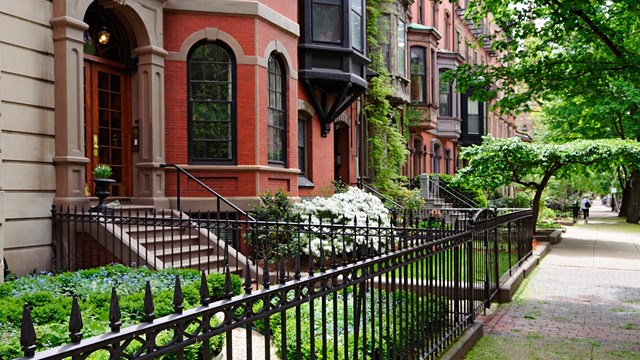It seems like a scene from a sci-fi or fantasy movie — giant bugs infesting the trees at the edge of a forest and endangering an entire ecosystem. Unfortunately, there is nothing fictitious about the Asian Longhorned Beetle (ALB), which was discovered in northern Worcester, Massachusetts, last year.
“ALB has been described as being worse than chestnut blight, Dutch elm disease and gypsy moth combined,” says Dr. Robert Childs, an entomologist and extension outreach specialist based in the UMass Extension Plant Diagnostic Lab at the University of Massachusettsin Amherst, Massachusetts.
“Chestnut blight and Dutch elm disease are no longer big deals here because we don't have those trees anymore. Gypsy moth is no longer a serious threat because after 140-plus years of its being in Massachusetts, a natural control agent has been found to limit its numbers. No such control agent has yet been found for these beetles, and their effects could be devastating on many levels if their growth is not halted,” Childs says.
Because the beetle was accidentally brought here from abroad, “there are few if any predators that will eat the ALB in the U.S.,” says Suzanne M. Bond, a spokesperson with the U.S. Department of Agriculture's Animal and Plant Health Inspection Service (APHIS).
Adding fuel to the fire is that no lures have yet been developed to successfully attract the beetles and trap them to control their populations. And finally, the insect prefers to infest healthy, viable trees as opposed to stressed and dying trees. These facts, coupled with the array of tree species that it will infest, make the ALB a significant and dangerous pest.
While the beetle has been found in the U.S. previously, its earlier locationswere much more definitively urban.
Its presence in northern Worcester, however, gives it close proximity and potential access to the Northeastern hardwood forest. The forest abutting the northern edge of Worcester runs all the way up to New Hampshire, and some officials in that state are concerned that the beetle, while as yet unidentified there, may have already arrived. “It’s not really known what it means if [the ALB] gets into the forest — but we don't want to find out. In the long term, if the beetles are not stopped, it is entirely possible that the entire New England ecosystem could be altered, with harmful effects on real estate, tourism, the maple-sugar and lumbering industries, soil erosion, carbon emissions, and even recreation,” says Childs.
Up to 20,000 Trees Affected
Anywhere from 6,000 to 20,000 Worcester trees will have to be cut down to halt the ALB outbreak. This includes those that are known to be infested, but both APHIS and the Stateof Massachusetts are encouraging the removal of high-risk host trees as well, to prohibit spread of the insect. Residents in north Worcester and its environs received a registered letter from the state detailing these matters, accompanied by a form to be filled in and signed to indicate support of the high-risk tree removal on their properties as well. Although some local officials have expressed doubt that such extreme measures need to be taken, most residents have responded amenably to the letter.
Attacks 11 Tree Species
Unlike other blights and pests which often attack only one plant species, the Asian Longhorned Beetle is known to feel at home in at least eleven species of trees found in New England. Maples are a favorite of the insect, but condominium associations looking for the beetle also need to inspect also any horse-chestnut, birch, London plane, poplar, willow, elm, ash, mountain ash, mimosa, and hackberry trees on their properties. Childs pointsout that “landscape trees contribute significantly to real-estate values and aesthetics,” giving condo owners and managers even more reason to take this threat seriously.
The beetle’s life cycle starts during the summer months, when it lays its eggs in the bark of a host tree. In the winter and spring, the larvae are busy tunneling into the wood of the tree, undermining its strength and integrity and thus slowly killing it. In the following summer the newly-matured beetles leave the tree through “exit holes” and begin the process again. A strong and healthy tree can sustain this kind of trauma for eight to ten years, but the damage possible in the ensuing period is significant. It is now known that the beetles have been present in Worcester since at least 1997, though thedamage is only now being detected.
This only serves to highlight the need of condos to take the threat seriously and consistently inspect the trees on their grounds. “How long an ALB infestation can take to kill a tree depends on the size and health of the tree and the number of host trees around it,” explains Bond. “A smaller tree will feel the impacts of the larval tunneling sooner than a larger tree with many branches and limbs. A solitary host tree will feel the impacts sooner than a stand of host trees. It could be as many as seven years beforea tree dies completely. But before the tree succumbs, limbs and branches will certainly be weakened and die. This causes a safety hazard for those people, vehicles and animals walking underneath. And, the tree is home to generations of ALB before it does die, helping the infestation to persist and even spread.”
As if beetle proliferation and spread to neighboring trees wasn’t bad enough, there is also the danger of migration through the transport of wood. The Asian Longhorned Beetle arrived in this country — and, as far as anyone can tell, in Massachusetts itself — via the wood of packing pallets and crates importing products from Asia. These insects can also grow and winter in cut firewood, leading to what Bond calls “satellite infestations,” as happened when firewood was transported betweenNew York City and Long Island.
The danger of satellite infestations in Worcester County increased dramatically after the freak ice storm which pummeled parts of New England in December 2008. With so many felled trees and branches littering the region, it became imperative to conduct clean-up operations without risking transporting the beetle larvae further afield. The regulated area has been quarantined to prevent the entry or exit of wood, and all wood that not burned on-site had to be chipped to an inch by an inch in two dimensions. At that size, the larvae cannot survive, and the wood chips created after the ice storm, as well as the ones being produced during the intentional tree-fellings, can be safely moved offsite, where they will be burned.
Any other removal of wood from the regulated area, however, is strictly illegal. Condos within the regulated area, or in any future regulated areas, must under no circumstances transportwood outside of their borders. Boards and managers must be vigilant about this. Quarantined wood includes everything from branches and entire trees to firewood and green lumber.
Childs, who has been studying the beetle and educating people within the “green industry” — garden centers, tree wardens, landscapers, arborists — insists, “Landscape and tree companies cannot sell services such as “insecticideinjection” to protect clients’ trees, nor can they take down trees unless the USDA has instructed them to do so via a special contract.” He maintains that “the only known way to treat [the beetle] is to eradicate it, and the only way to eradicate it is to take out the tree.”
Because adult beetles can fly, this means that for every infested tree, other high-risk host trees within a quarter of a mile should also be taken down. Childs warns, “In Worcester alone, it’s probably fair to say that 20,000 trees will be taken out in the next couple of years. Numbers fluctuate, and the survey will take years.”
While it is vital and positive to have the government’s support and financing for this mammoth endeavor, this is not just “their problem.” The ramifications of the bug’s presence couldaffect the landscape, the ecosystem and the economy for years to come.
On a smaller scale, residents of the infested area are finding themselves active participants in the battle against the beetles, and their contribution should be promoted and not underestimated. Worcester can be an example to the rest of New England: negatively in its finding the beetles so late due to ignorance of the danger, but positively in the full-fledged cooperation of its residents with the eradication program. Condos across New England should be educated about the beetles and informed about what to do if they see one.
How to Spot the Pest
At a minimum, they should know what they are looking for. The beetles range from 3/4 to 1 1/2 inches long, with antennae at least as long (in females) or twice as long (in males). Adults are a shiny black, sporting white spots on their backs and alternating black-and-white bands on their antennae. Even if the insects themselves are not visible, property owners can identify their presence by other markers, such as exit holes, as well as the dime-sized pits in the bark of trees where the females have laid their eggs. “Frass,” or wood-dust, may be visible at the base of trees, and in some extreme cases, the larval feeding galleries themselves may be exposed.
Clint McFarland, manager of the Massachusetts ALB program from the federal side, reminds us that every single initial ALB discovery in the United States was made not by a specialist, but by ordinary citizens.
This has enormous implications for condominiums because their property managers and board members have the power to educate many people at once and get them behind the eradication effort.
While it is hoped that Massachusetts is the only New England state with an ALB population, there is no guarantee. McFarland admits that in spite of the big push at publicizing the problem, many people are still unaware of the issue. While people like Robert Childscan educate landscapers, others are needed to promote cooperation among householders.
Cooperation affects every stage of the program, from identification of the insect’s presence, to reporting, to allowing access, to permitting the removal, not just of infested trees, but of at-risk trees as well. McFarland assures condos that “the more a community can invest in this, the better it is for all of us.” He says, “Our people take a lot of pride in what we’re doing.” So can condo owners, managers and boards as they take a stand to keep the Asian Longhorned Beetle out of their condominium’s landscapes.
Jennifer Grosser is a freelance writer and a frequent contributor to New England Condominium magazine.






Leave a Comment